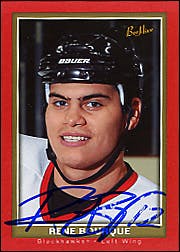Bourque: How much? How long?

Of all the potential unrestricted free agent cases this summer, Rene Bourque’s is the most "most."
For starters, the winger is in line for the most increase as he will certainly at least double his current pay rate of $1.4 million per annum. None of the other pending UFAs (Craig Conroy, Eric Nystrom, Chris Higgins, Matt Stajan, Jamal Mayers, Brian McGrattan and Aaron Johnson) are likely to get that kind of raise and a few are at risk of not getting a contract offer at all.
Bourque’s file is also the most important in Darryl Sutter’s dossier because the other UFAs either have lesser roles with the Flames or haven’t been in Calgary long enough to integrate themselves so fully into the fabric of the team that their departure would leave a gaping hole.
Finally, Bourque’s case is also the most intriguing because there are so many intangibles and variables in the equation.
If you put any stock in messageboard gossip, there’s a report the Flames are on the verge of announcing a six-year, $20-million extension with the 28-year-old from Lac La Biche, Alta. The numbers seem odd from both sides of the equation, but then again placing an appropriate dollar value and time investment on Bourque is no easy task.
Just for kicks, let’s say those contract figures are in the ballpark. That’s an annual salary of $3.33 million, which would make Bourque just the seventh-highest paid skater among the 13 Flames signed for 2010-11. Considering how often — too often, critics would hastily suggest — Bourque has been the Flames’ best skater over the past couple of seasons, the number seems low. Just for an extreme apples-and-oranges example, Bourque and Michael Cammalleri both potted 20 even-strength goals for Calgary a season ago and Cammalleri parlayed his season into a contract that will pay him an average of $6 million over the next five seasons.
On the flip side, six years would be an awful long commitment for a player who has shown no ability to stay healthy and, given his rambunctious and sometimes reckless style, is a poor candidate to turn into Doug Jarvis as he hits his 30s. Bourque was injured heading into the Olympic break and has missed 91 games and counting over the past four seasons with various ailments. It’s not to say Bourque is soft — in fact, he would have missed many more contests had he not the capacity for playing hurt — but he just fits into the Ryan Smyth/Brenden Morrow category of player whose style exacts a heavy toll on his body.
When looking at the 2009 crop of free-agent forwards, it’s a real struggle to find a comparable for Bourque in terms of age, style and productivity. Below, you’ll see a chart that compares Bourque’s projected 2009-10 numbers to the statistics posted by 2009 free agents who were very vaguely in Bourque’s ballpark in terms of age and contract-year production. The best comparable might go back to the summer of 2008, when Pittsburgh’s Ryan Malone hit the open market.
Even ignoring the significant differences in player types, finding Bourque’s relative value to those players is problematic because he’s outscored most of them but has also been less durable. While Malone is the best match style-wise, his contract from the early days of the Oren Koules/Len Barrie era in Tampa is only useful in a "those who do not learm from history are doomed to repeat it" sort of way.
So, if you’re Flames GM, what term and what terms do you give Bourque? Even in the light of the questionable trend of giving longer-term contracts to soften the cap hit, wouldn’t a shorter contract (three years at most) for a little more loot make the most sense?
It will interesting to see if there’s any truth to the gossip about a six-year deal (with presumed no-trade protection) when one of the main motivations behind the Dion Phaneuf deal was that the Flames had too many dollars tied up for too many years on too many immovable contracts.
Recent articles from Jean Lefebvre





